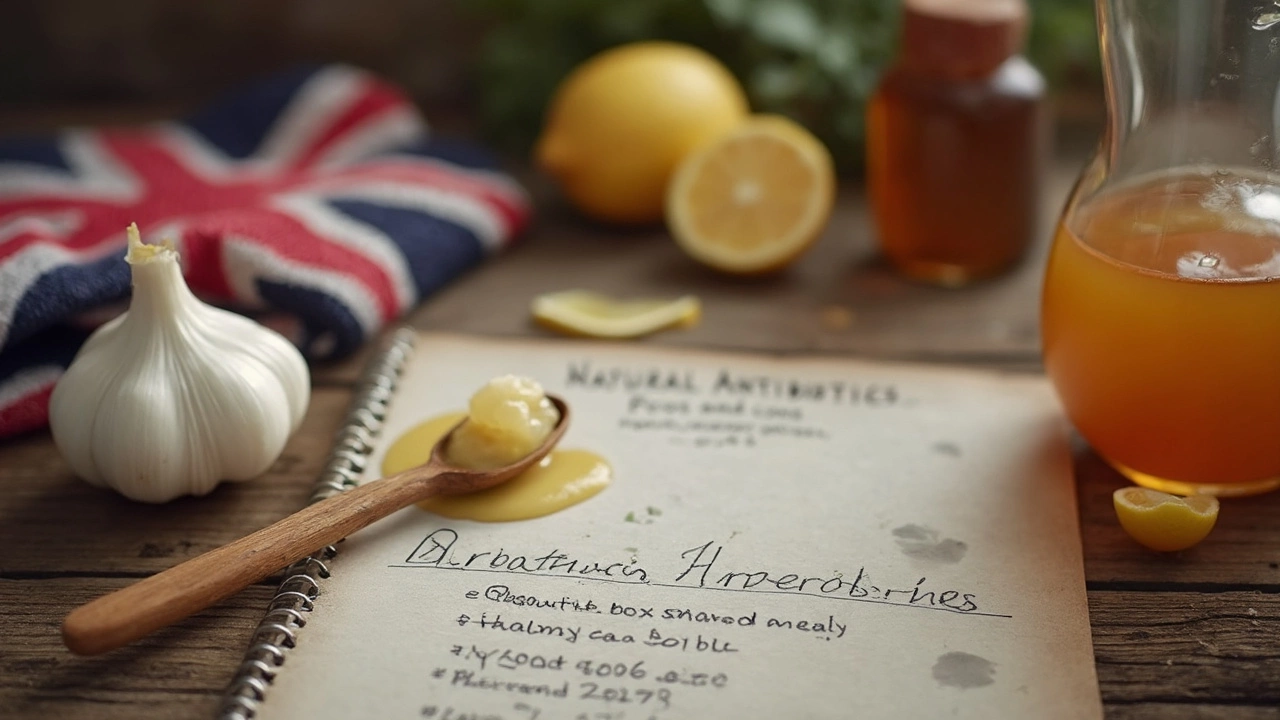If you’re fighting an infection, you’ve probably heard that some natural antibiotics can help. But what’s the real deal? Spoiler: not all remedies are created equal, and some of the “miracle cures” trending online are mostly hype.
Antibiotic resistance is on the rise and prescription meds don’t always play nice with everyone’s body. No wonder so many folks are on the lookout for a natural fix—something that works without the scary side effects. People have been using garlic, honey, and herbal teas for centuries, but are any of these actually as strong as modern antibiotics?
Here’s where things get interesting. Just because something’s natural doesn’t mean it’s mild. For example, crushed raw garlic packs a punch, producing a compound called allicin. It sounds simple but it can actually stop some bacteria in their tracks (though your breath might scare away more than just germs). Manuka honey is another wild card—real science shows it can kill bacteria and even speed up wound healing. The catch is, not every jar is created equal and supermarket honey won’t cut it.
Still, before you start eating cloves or slathering honey on every scrape, let’s get real: natural antibiotics aren’t magic. They don’t work for every germ, and some home remedies might do more harm than good, especially if you have allergies or take other meds. Nothing beats a proper diagnosis from your doctor. But if you’re curious which natural option is the strongest—and when it makes sense to use one—stick around. Let’s separate solid facts from wishful thinking.
- How Natural Antibiotics Work (And Don’t Work)
- The Top Contenders: Garlic, Honey, and More
- Risks, Side Effects, and What to Watch Out For
- When to Ditch the Home Remedies and Call a Doctor
How Natural Antibiotics Work (And Don’t Work)
People are always looking for a strong natural antibiotic when an infection hits, but it’s not as simple as picking something from your kitchen shelf and expecting it to work like a prescription drug. Natural antibiotics, like garlic or honey, usually kill bacteria by disrupting their cell walls or messing with how they grow. Allicin in garlic, for example, actually damages the cell wall of some nasty bugs, making it harder for them to survive. Manuka honey can draw water out of bacteria, basically dehydrating them to death.
But here’s the catch: natural antibiotics don’t always attack every type of bacteria, and they usually aren’t as targeted as what you’d get from a pharmacy. Prescription antibiotics are designed to zero in on a specific infection, wiping out bacteria fast. Most natural options, at best, can help prevent mild infections from getting worse or give your immune system some backup—but they aren’t the heavy hitters you need for something like strep throat or a deep wound.
Some folks swear by herbal teas, oregano oil, or apple cider vinegar, but the science is hit or miss. For example, one table below shows how natural remedies compare to basic antibiotics for certain bacteria:
| Bacteria Type | Prescription Antibiotic | Natural Remedy |
|---|---|---|
| Staphylococcus aureus | Very effective | Manuka honey (sometimes effective) Garlic (mild effect) |
| Streptococcus pyogenes | Very effective | Garlic (often weak) |
| Escherichia coli | Very effective | Garlic, oregano oil (mild effect) |
The takeaway? Natural antibiotic options may help with surface wounds or very mild infections. You’ll get some perks—fewer side effects, less risk of resistance—but you’re also hanging out in the shallow end of the pool. If you want serious results, don’t skip the professional help for tough or stubborn infections. And forget about treating viruses like the flu with natural antibiotics—they only fight bacteria, not viruses.
The Top Contenders: Garlic, Honey, and More
When it comes to natural antibiotic options, garlic and honey are practically celebrities. But a few other natural remedies are worth mentioning, too. Let’s cut through the confusion and see how they really stack up.
Garlic is tough to beat. Smash up a fresh clove and you get allicin, a compound known to kill bacteria, viruses, and even some fungi. In one lab study, allicin was about as effective against staph bacteria as a low dose of prescription antibiotics. Raw, crushed garlic is much stronger than cooked—so if you want the real effect, that’s how you have to use it.
Honey—specifically Manuka honey from New Zealand—has gotten a lot of buzz (pun intended) for fighting infections. Hospitals sometimes use it for wound healing. It works by creating a hostile environment for bacteria and drawing moisture out of wounds. Regular honey helps a little, but Manuka has a special compound (methylglyoxal) that’s way more powerful.
Here are a few other top picks if you're thinking about home remedies for infection:
- Oregano oil: Contains carvacrol and thymol, which fight bacteria like E. coli and Salmonella, but this oil is super strong—never use undiluted on your skin or take it straight.
- Tea tree oil: Handy for skin infections (think cuts or acne), but don’t swallow it—it’s poisonous if ingested.
- Echinacea: There’s some research showing it might cut down cold duration, but don’t expect miracles with bigger, meaner infections.
If you like numbers, check this out:
| Natural Antibiotic | Main Use | Key Compound |
|---|---|---|
| Garlic | Broad spectrum (internal & topical) | Allicin |
| Manuka Honey | Wounds, topical infections | Methylglyoxal (MGO) |
| Oregano Oil | Respiratory, gut, skin | Carvacrol, Thymol |
| Tea Tree Oil | Skin | Terpinen-4-ol |
Remember: these strongest antibiotic home remedies won’t always replace a doctor’s prescription, but they’re not just old wives’ tales either. If you decide to try one, make sure you know how to use it safely—and always double-check with your doctor if you have any health conditions or take medication.

Risks, Side Effects, and What to Watch Out For
Don’t let the word “natural” fool you. Just because a remedy shows up in your kitchen or at the local health store doesn’t mean it’s safe for everyone. When it comes to hunting for the strongest natural antibiotic, you still need to think about allergies, interactions, and good old-fashioned overuse.
Take raw garlic for example—it’s famous as a natural antibiotic, but eating too much can do a number on your stomach. Nausea, heartburn, and even mouth irritation are pretty common, especially if you munch on it raw. Garlic also thins your blood, so if you’re taking blood thinners or heading in for surgery, you need to talk to your doctor first.
Honey—especially Manuka—sounds like a dream cure, but it’s not perfect either. Never give honey to babies under age one. Their systems just can’t handle it, and there’s a real risk of botulism, which is way more than just a tummy bug. For grown-ups, allergy to honey is rare, but it happens. A quick patch test can save you a major reaction.
Before you try any home infection fix, check your other meds. Even “safe” herbs and supplements can mix badly with stuff like insulin, blood pressure pills, or immune suppressants. Sometimes the natural and the pharmaceutical worlds just don’t play nice together.
- Watch for allergic reactions: Itching, swelling, rashes, or trouble breathing can mean you need help fast.
- Skip the “more is better” thinking: Overdoing garlic or oregano oil can actually burn your mouth or cause diarrhea.
- Don’t swap natural stuff for real antibiotics if you have a deep cut, fever, or any spreading infection. Home remedies just don’t go that far.
If you want stats, check this out: A 2023 hospital report found 15% of adults using herbal or “natural antibiotic” remedies got unexpected side effects—mostly tummy trouble or skin reactions. That’s not rare.
Bottom line? Check ingredient lists, watch doses, and always tell your doctor what you’re actually taking. Trying to treat a simple cold is one thing, but playing pharmacist for anything more serious can backfire fast.
When to Ditch the Home Remedies and Call a Doctor
Even the strongest natural antibiotic can only go so far. Sometimes, relying on garlic or honey is like bringing a butter knife to a sword fight—especially if you’re dealing with a stubborn or fast-spreading infection. Real talk: some problems just need a professional opinion.
So how do you know when it’s time to put the kitchen cures aside and talk to an expert? Watch for these clear signs:
- Your fever won’t go away (especially if it’s over 38°C or 100.4°F for more than three days).
- You get chills, confusion, or trouble breathing. None of these are normal with a simple cold.
- You have red streaks spreading from a wound—or the area is hot, swollen, or leaking pus.
- After trying a natural antibiotic or a common remedy, your symptoms haven’t budged after 4-5 days. Sometimes things even get worse.
- You keep throwing up, can’t eat or drink, or you have diarrhea for more than two days.
- There’s pain or swelling in your joints, or you can’t move a limb the way you normally can.
Here’s something that’s worth actually knowing. Around 20% of soft tissue infections, like cellulitis, end up needing serious medical attention if you don’t treat them early enough. See the table for a quick breakdown of things that usually need a doctor:
| Symptom | Possible Problem |
|---|---|
| High fever + chills | Systemic infection, possibly sepsis |
| Swollen/red wound | Bacterial infection (like cellulitis) |
| Shortness of breath | Pneumonia or another lung infection |
| Confusion/slurred speech | Serious infection spreading |
It’s easy to lose track of time waiting for home treatments to kick in. If you use a natural antibiotic like garlic or honey and nothing changes, or if you start a new symptom that worries you, reach out for online doctor consultation. Most clinics now offer quick video consults, so you don’t have to drag yourself across town just to get checked out.
One last thing: antibiotics only work on bacterial infections—not viruses or fungi. Common “antibiotic” home remedies are the same. If you have something like strep throat or a urinary tract infection, don’t mess around. Go get tested and save the garlic for your pasta.




